Industry 4.0, often referred to as the fourth industrial revolution, is transforming the landscape of manufacturing and production through the integration of advanced technologies. Among these technologies, robotics plays a pivotal role in driving automation, efficiency, and innovation. As robotics becomes increasingly sophisticated, it is reshaping industries and redefining the future of work.
Understanding Industry 4.0
Industry 4.0 represents a new era of smart manufacturing, where cyber-physical systems, the Internet of Things (IoT), artificial intelligence (AI), and big data converge to create interconnected, intelligent production environments. This revolution builds upon previous industrial advancements, moving beyond traditional automation to systems that can communicate, analyze, and make decisions with minimal human intervention.
The Rise of Robotics in Industry 4.0
Robotics has been a cornerstone of manufacturing for decades, but its role has evolved significantly in the context of Industry 4.0. Today’s robots are not just programmable machines performing repetitive tasks; they are highly adaptable, collaborative, and intelligent systems capable of performing complex operations. Here are some key ways robotics is shaping Industry 4.0:
- Advanced Automation: Robotics in Industry 4.0 enables unprecedented levels of automation. Robots can operate around the clock with precision and consistency, reducing human error and significantly increasing productivity. In industries such as automotive, electronics, and pharmaceuticals, robots are essential for tasks that require high accuracy and speed, such as assembly, packaging, and quality inspection.
- Collaborative Robots (Cobots): Unlike traditional industrial robots that are often isolated from human workers for safety reasons, collaborative robots, or cobots, are designed to work alongside humans. Cobots enhance human capabilities, taking on physically demanding or repetitive tasks, allowing workers to focus on more complex and creative aspects of production. This collaboration between humans and robots increases efficiency while maintaining flexibility in manufacturing processes.
- Flexible Manufacturing: Robotics contributes to the flexibility required in Industry 4.0, where production lines can quickly adapt to changes in product design, demand, or custom requirements. Modern robots can be easily reprogrammed and reconfigured, allowing manufacturers to switch between different products or processes without significant downtime. This flexibility is crucial for meeting the demands of today’s market, where customization and rapid product cycles are the norm.
- Predictive Maintenance: Robotics integrated with AI and IoT enables predictive maintenance, where sensors and analytics are used to monitor the health of machines and robots in real-time. By predicting when a machine is likely to fail, companies can perform maintenance before breakdowns occur, reducing downtime and saving costs. This approach also extends the lifespan of equipment and ensures continuous, reliable operation.
The Future of Work in the Age of Robotics
The integration of robotics in Industry 4.0 is not just changing how products are made; it’s also transforming the workforce. As robots take on more tasks, the nature of work is shifting from manual labor to roles that require higher levels of technical skills, creativity, and problem-solving. Here are some implications for the future of work:
- Skill Development: The rise of robotics emphasizes the need for workers to develop new skills, particularly in areas such as robotics programming, AI, and data analytics. Educational and training programs are increasingly focusing on these skills to prepare the workforce for the demands of Industry 4.0.
- Job Transformation: While some jobs may be displaced by automation, new roles are emerging that focus on managing, programming, and maintaining robotic systems. Additionally, jobs that require human creativity, emotional intelligence, and complex decision-making are likely to see increased demand.
- Human-Robot Collaboration: The future of work will likely involve closer collaboration between humans and robots. This partnership will enable more efficient and innovative production processes, where humans provide the creativity and oversight, while robots handle routine tasks.
Conclusion
Robotics is at the heart of Industry 4.0, driving automation, innovation, and a new era of manufacturing. As robotics technology continues to advance, it will reshape industries and redefine the future of work. Embracing these changes requires a focus on skill development, job transformation, and the potential for human-robot collaboration. By understanding and preparing for the role of robotics in Industry 4.0, businesses and workers alike can thrive in this new industrial landscape.
